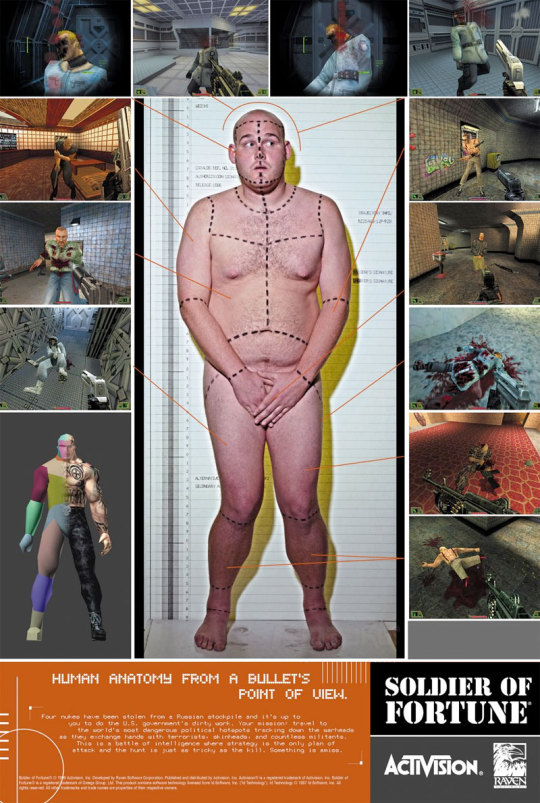Photo
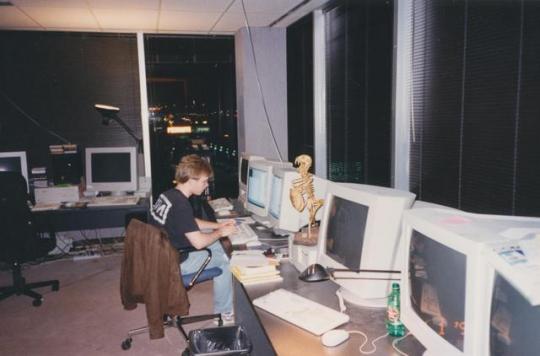



Four rare photographs from the War Room, where id Software huddled together in early 1996 to try and finish Quake.
In clockwise order: John Carmack, John Romero, Michael Abrash and Adrian Carmack, and American McGee. From Masters of Doom:
As 1996 rolled around, not only was id at war with GTI but it was at war with itself. The decision to abandon Romero's design for Carmack's technology created incinerating pressure. The company was in perpetual crunch mode, trying to get the Doom-style shooter done by March. Carmack, feeling like he was the only one running the ship, decided it was time to turn up the heat. For weeks he had been working out in the hallway to keep an eye on everyone else. but now he suggested they tear the walls down.
They had no idea how messy the war room would be. Within days, walls began crashing around them, blanketing the area in powder dust. They lined tables up against the windows and piled on their computers, sitting by each other with barely enough room to grab a soda without knocking elbows.
Without the privacy of personal space, the tension began to mount. They worked eighteen-hour days, seven days a week.
These photos were borrowed from Rocket Jump: Quake and the Golden Age of First Person Shooters, a fantastic 125,000 word article by David Braddock published on Shacknews. Go read it now, it's well worth whatever they ask for it.
279 notes
·
View notes
Text

When I picked the name "texelstorm" for this Tumblr, I firmly had Quake in mind. A frenzied, furious, gritty, lightmapped, mipmapped, perspective-warped world that lived behind the thick glass of my 13" CRT monitor twenty years ago.
Many hours I walked the cyclopean halls and cold corridors, past lava and slime and through slipgates and teleporters. I danced with thousands of Ogres and Demons and Shamblers and Vores, bounced multitudes of grenades around the impenetrable brush surfaces, unleashed hailstorms of nails through the nodes and leaves of each map's BSP tree.
Twenty years after its release, Quake stands as the stark, hideous, scifi-meets-fantasy-meets-industrial foundation that first-person gaming rests on — and it's still a bloody great game to play! id Software, please make Quake Champions as great a tribute to the Quake series as Doom 2016 is to Doom.
93 notes
·
View notes
Photo

Brilliant Quake fanart by Lukasz Jaskolski. This makes me wonder what an id Tech 6-powered Quake reboot could be like. id Software has been showing a lot of love for Wolfenstein 3D and Doom lately — I wonder if us old-school Quake fans will ever get the same amount of attention. A boy can dream.
76 notes
·
View notes
Video
youtube
RetroAhoy's retrospective on Doom: its origins, its overwhelming importance to the FPS genre and its enduring legacy.
And now that this superb 50-minute love letter to Doom has put you in the mood, why not try John Romero's awesome E1M8 reboot?
10 notes
·
View notes
Photo

Boy genius Ken Silverman, eighteen years old, working on the Build engine in 1994.
Ken Silverman was a programming prodigy, starting his journey on a Texas Instruments TI-99/4A in 1983 at the tender age of eight. By the time he finished high school he had created Ken’s Labyrinth, a Wolfenstein 3D clone with a lighthearted funhouse theme he managed to publish through a young company called Epic Megagames.

Apogee Software took notice and offered Silverman, barely eighteen at this point, a contract to develop a new 3D engine for them. He had already done some work on an improved version of the Ken’s Labyrinth engine with angled walls and lighting effects, while John Carmack was doing the same for his Doom engine down in Texas. This is not to say the two were rivals; on the contrary, they talked on the phone from time to time and inspired each other’s work. For example, Silverman took the idea of sector-based levels from Carmack and found it let him get around the limitations of the grid-based paradigm he had been working with.
Over the next eighteen months or so, with Ken mostly working remotely from his parent’s home in Rhode Island with occasional trips down to the newly formed 3D Realms’ offices in Texas, the BUILD engine developed into a very capable and feature-rich 3D engine. It supported sloped floors, fake room-over-room, decals sprites on walls and floors, moving sectors for effects like vehicles and swinging doors, and many other interesting features.
youtube
Overall, the tech never felt quite as fundamentally solid as Doom or Quake, and its 2.5D nature made it an evolutionary dead-end by the time Duke Nukem 3D was released in 1996. But in the hands of 3D Realms’s designers BUILD enabled the quirky, colorful, richly interactive game worlds of Duke3D, Shadow Warrior and Blood — three superb shooters that brought a sense of fun to a genre that was then practically dominated by the sparsely designed, monolithic Quake.
Silverman continued to do great programming work post-BUILD, as evidenced by his awesome vintage-styled homepage — a treasure trove of old-school 3D programming wizardry. Yet he never grew into a game technology luminary like Carmack or Tim Sweeney. Here is Carmack in an interview from 1997, asked who he would hire if he could pick anyone from the 3D tech field:
“If I had to pick who I think is just the most talented, it would probably be Ken Silverman, the guy that did the BUILD engine. […] He writes all the code for everything, and he’s just extremely talented. I think it was one of 3D Realms’ worst decisions not to coddle him, or whatever it took, to keep him on board. I think if he was still working directly for 3D Realms, they would have a Quake-type game shipped by now, just because he’s extraordinarily good.”
It’s hard to talk about the history of 3D game engines without mentioning John Carmack, and deservedly so. But let’s not forget that teenage boy sitting at his 13" CRT monitor somewhere in Rhode Island over twenty years ago.

335 notes
·
View notes
Video
youtube
A playthrough of the Half-Life 0.52 alpha, a prerelease build of the game from September 1997 that was leaked to the public in 2013.
It's remarkable how much of the gameplay and environmental sophistication that would make the game such a landmark title are already present here, even as the engine still carries a lot of flavor from the Quake technology it was based on.
A lot of the content here would end up in the release version, but some of it was discarded completely. In terms of level design I particularly like the underground sections with Marine combat around the 20 minute mark. And how strangely retro to see the sub-machinegun implemented as a projectile weapon.
Valve's development process for the original Half-Life deserves a lengthy post of its own. In the meantime, an ISO of the alpha CD-ROM is available on ModDB.
147 notes
·
View notes
Photo



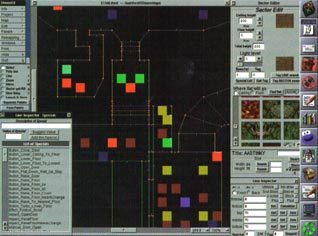



Level editors I have known and loved.
From top to bottom:
The BUILD editor for Duke Nukem 3D.
QuakeED for Quake, running on NEXTStep at id Software.
DoomED for Doom, ditto.
WorldCraft for Half-Life.
UnrealEd for Unreal.
Q3Radiant for Quake 3 Arena.
85 notes
·
View notes
Photo
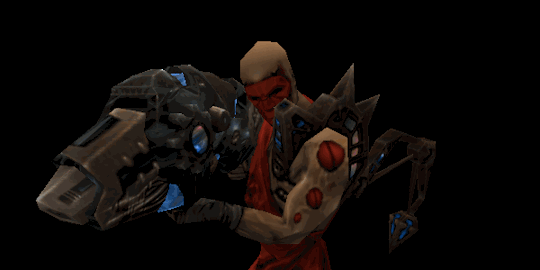
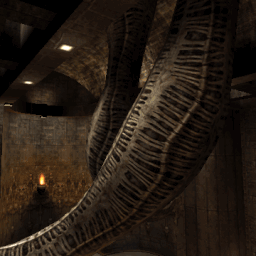


The id Tech 3 engine was developed between 1997 and 1999, before the age of programmable vertex and pixel shaders -- yet it allows surface and geometry effects that range from pretty neat to downright impressive for the time. The secret behind these is the engine's own version of shaders, based on standard OpenGL features available in GPU’s as early as 1996. id Tech 3’s shader system is based on the basic common feature set of GPU’s at the time, relying on clever combinations of multitexturing, blending stages, cubemaps, animated UV transformations and vertex animation on the CPU to produce a wide range of effects. These are captures from Quake 3 Arena, but later games like Heavy Metal: FAKK 2, Elite Force and American McGee's Alice made great use of the tech as well. Surface parameters are defined in a simple text format, effectively providing a declarative scripting language for OpenGL’s fixed function rendering pipeline. id even published a pretty comprehensive manual for shader authors, one of the rare times it made internal technical documentation public to the mod community. The shader system was made possible only by a clear choice on id's part to require dedicated 3D hardware that had barely just become mainstream at the time. It made Quake 3 one the most visually interesting and vibrant first-person shooters of all time, and helped establish id Tech 3 as the go-to technology for many great-looking games well into the 2000's.
345 notes
·
View notes
Video
youtube
Devs Play: Doom with John Romero! Double Fine Productions just put out this 10-part half-interview, half-Let's Play of Doom with John Romero himself. Very well-produced and insightful as always. Now if only they could pull Carmack and Abrash away from their VR goggles for a couple of hours and do a similar thing on Quake.
6 notes
·
View notes
Photo
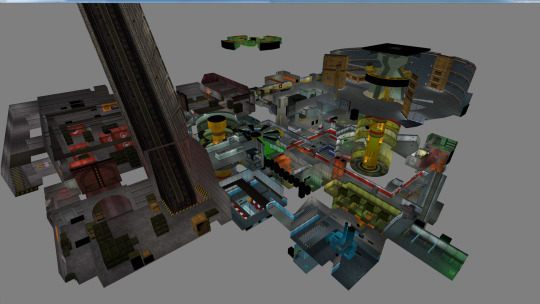


HalfMapper is an open-source tool available on GitHub that extracts level data from Half-Life and other GoldSrc games for rendering.
I love this kind of data archeology, pulling information from a 15 or 20-year old piece of software and using new tools and technologies to do interesting things with it.
Also, it turns out that when you combine all of Half-Life into a single connected space, it starts to look like the world's awesomest Metroidvania-style exploration game.
234 notes
·
View notes
Photo

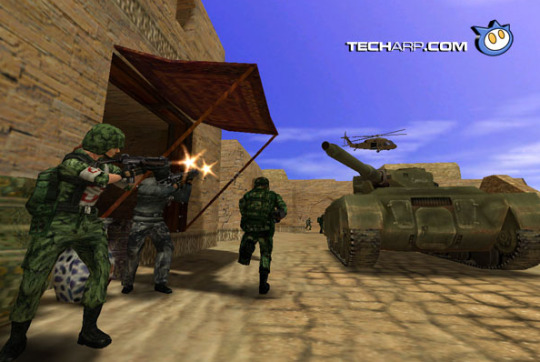




Team Fortress 2: Brotherhood of Arms in 1999. Valve originally went for a militaristic design, making this version of the game look more like a Counter-Strike with military character models instead of the fun, heavily stylized TF2 of today. Valve was pushing the GoldSrc engine here with higher-polygon characters and environments, parametric animation and dynamic LOD. All of that was eventually scrapped with the move to the Source engine in the early 2000's. There is also some pretty low-fi footage German magazine GameStar shot off a CRT monitor back in 1998, which is the only footage of this version of the game I'm aware of.
241 notes
·
View notes
Video
youtube
Quake being rendered on an oscilloscope.
My nerd pleasure center just melted.
61 notes
·
View notes
Photo

Anyone with access to an Oculus development kit and a copy of Quake owes it to themselves to check out Quakespasm Rift. Suddenly finding yourself truly inside these environments, in the presence of these monsters you've been seeing and hearing and interacting with through glass for over 15 years... it's really quite something.
Also, thanks for following this feed and have a good 2015 everyone! I intend to post more consistently throughout the new year and cover lots of topics on lots of different games. There's a ton more oldschool FPS love to go around.
98 notes
·
View notes
Photo
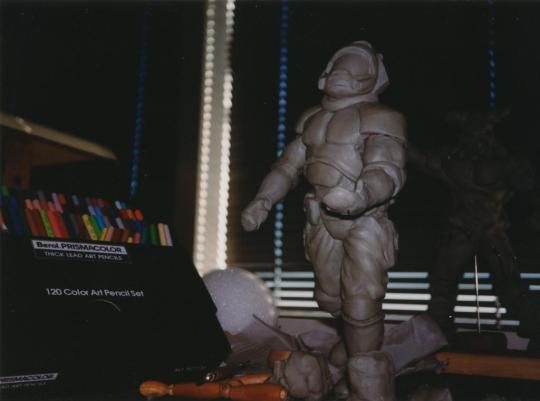

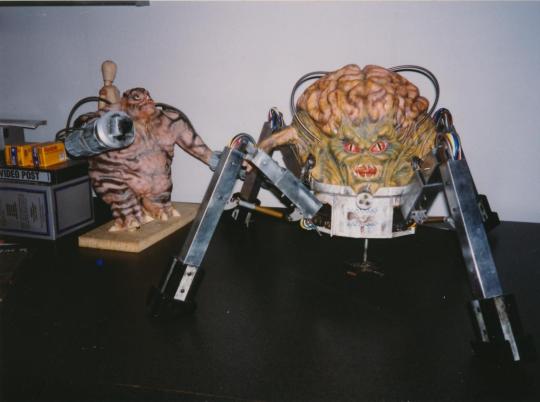



Clay models for the Doom guy, Mancubus, Spiderdemon, Cyberdemon and Baron of Hell from Doom's production, plus original design drawings. Adrian Carmack and Gregor Punchatz at the top of their game back in 1993.
53 notes
·
View notes
Photo

Pile of meat, never used. Maybe it was too gross in 1993.
– @romero
164 notes
·
View notes


